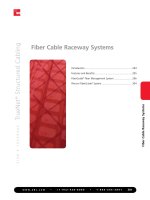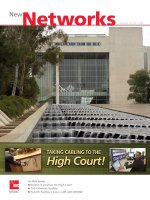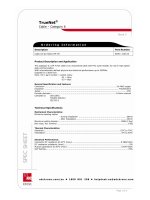Tài liệu ADC KRONE - Technical Reference - TrueNet Structured Cabling System solution ppt
Bạn đang xem bản rút gọn của tài liệu. Xem và tải ngay bản đầy đủ của tài liệu tại đây (3.09 MB, 32 trang )
TrueNet
®
Technical Reference
WHITE PAPER
Imagine trying to link railroads together that are based on different gauges, to build anything with
a combination of metric and American parts, to type a letter on something other than a QWERTY keyboard,
or to wire a building for voice, data and video if all the components had different requirements.
The key to simplifying all these tasks is standardization. Bringing standards to the wiring and cabling
segments of the building industry has enabled the industry to define a common infrastructure that allows
many companies to provide common components. Strict adherence to these standards benefits everyone.
ADC’s Position on Standards
ADC is a strong proponent of standards-based design for structured cabling systems. A strictly
defined set of standards helps ensure uniform application of physical layer networking products
and creates a usable infrastructure for communications networks.
However, ADC also believes that by nature, the standards evolve into a lowest-common denominator
indicator of performance. In order to accommodate various competing interests, a significant amount
of “flexibility” gets built into the allowable tolerances. The cumulative effect of these tolerances can
result in structured cabling channels in which different components can have radically different electrical
performance characteristics.
Consequently, when various standards-compliant components from randomly selected vendors are used,
the net result could be conformance to the standards, but not efficient performance.
The research undertaken by ADC for the TrueNet
®
structured cabling system revealed that only
a well-matched structured cabling channel that conforms to a tightly defined subset of the performance
standards is capable of flawless data transmission.
ADC, as a full system supplier, is able to deliver a complete system of well-matched components so
there is no guesswork. Choosing standards-compliant components randomly from unrelated vendors
will yield a standards-compliant channel, but may not result in optimum network performance.
Therefore, use the standards as a design guide, then make sure that you purchase standards-compliant
matched components.
1/05 • xxxxxxx
TrueNet
®
Technical Reference
Technical Reference
Industry Standards
3
www.adc.com • +1-952-938-8080 • 1-800-366-3891
The Benefits of Standards
Telecommunications
Rooms
Horizontal Cabling
Work Area
Entrance Facilities
and Equipment Rooms
Backbone Cabling
(Interbuilding)
Backbone Cabling
(Interbuilding)
The TIA/EIA-568-B Series standard defines a typical,
generic telecommunications cabling system.
Intermediate
Cross-Connects
Telecommunications
Rooms
Main Cross-Connect
Entrance Facilities
The entrance facility provides a connection point between the outside plant facilities—whether it is
public network services, private network customer premises or a combination of both—and the interior
premises cabling. Products used in this area include cables, connecting hardware, special protection
devices and other connecting hardware.
The demarcation point separating the service provider’s cabling and the customer’s cabling may be
part of the entrance facilities. Because the location of the demarcation point is determined by state
and federal regulations, the local regulated carrier (telephone service provider) or competitive access
provider should be contacted for detailed information.
The primary standards for this area are outlined in TIA/EIA-569-A, Commercial Building Standard
for Telecommunications Pathways and Spaces, and J-STD-607-A, Commercial Building Grounding/
Bonding Requirements.
ADC manufactures special overvoltage blocks, protection devices and building entrance terminals
for both fiber and copper cabling for use in this area.
Equipment Rooms
The TIA/EIA-568-B Series standard makes a distinction between equipment rooms and telecom-
munications rooms because of the nature of complexity of the equipment they contain. However, an
equipment room may alternately provide any or all of the functions of a telecommunications room.
Equipment rooms provide a controlled environment to house telecommunications equipment.
This equipment may include connecting hardware, splice closures, grounding and bonding facilities
and protection devices, where applicable. Switches, routers and other active equipment may reside
in the same rack or cabinet space as the passive cabling infrastructure.
In the premises cabling backbone hierarchy, an equipment room may contain either the main
cross-connect or the intermediate cross-connect. The equipment room may also contain network trunk
terminations and auxiliary terminations that are under the control of the premises cabling administrator.
The primary standards for this area are outlined in TIA/EIA-569-A, Commercial Building Standard
for Telecommunications Pathways and Spaces.
ADC manufactures a wide variety of fiber and copper patch panels, termination blocks and cable
management solutions that are well suited for this area.
Telecommunications Rooms
Telecommunications rooms may provide various functions for the cabling system and because of this
they are treated as a distinct subset in the cabling system hierarchy.
The primary function of a telecommunications room is to provide a termination point for horizontal
cable distribution, that supports all voice, data, video and other applications requiring structured cabling.
The telecommunications room also serves as a termination point for backbone cable. The cross-connection
of these two parts of the premises cabling is an important function of the telecommunications room.
Cross-connections may be accomplished using jumper wires or patch cords, and ADC products handle
both methods equally well.
Telecommunications rooms may also house cross-connects for different portions of the backbone
cabling system. These cross-connects are sometimes used to tie different rooms together in a ring, bus
or tree configuration.
1/05 • xxxxxxx
TrueNet
®
Technical Reference
Technical Reference
Industry Standards
4
www.adc.com • +1-952-938-8080 • 1-800-366-3891
Telecommunications rooms also provide a controlled environment for specific areas of a building. These
rooms may house telecommunications equipment, connecting hardware and splice closures as well as
devices such as routers and hubs. In some instances, the demarcation point and protection devices may
be located in a telecommunications room.
The TIA/EIA-568-B Series standard details cable routing and installation practices for telecommunications
rooms to prevent cable stress and to properly organize and manage cables.
Additional standards for this area are outlined in TIA/EIA-569-A, Commercial Building Standard for
Telecommunications Pathways and Spaces.
ADC manufactures a wide variety of blocks and patch panels capable of providing termination and
cable management for a wide range of wire sizes and cable types found in telecommunications rooms.
For More Information
Although this catalog presents a brief overview of information contained in the standard, persons
involved with the installation and maintenance of structured cabling systems should obtain a copy of
the complete standard and/or related standards.
1/05 • xxxxxxx
TrueNet
®
Technical Reference
Technical Reference
Industry Standards
5
www.adc.com • +1-952-938-8080 • 1-800-366-3891
FUSE
ON OFF
FUSE
ON OFF
Work Area
Work Area
Cable
Telcom
Outlet
Station
Field
Equipment
Field
Patch Cord
Data Hub
3M (Max) 90M (Max)
A + B < 10 M
Equipment CableStation Cable
Transition
Point
(Optional)
7M
AB
TIA/EIA-568-B Series Horizontal Channel/Link Model
Work Area
Work Area
Cable
Telcom
Outlet
Station
Field
Equipment
Field
Patch Cord
Data Hub
5M (Max)90M (Max)
A + B + E < 10 M
Equipment CableStation Cable
Transition
Point
(Optional)
ABE
ISO/IEC 11801 Horizontal Channel/Link Model
Technical standards that address various aspects of commercial cabling include:
• TIA/EIA-568-B Series, Commercial Building Telecommunications Cabling Standard
• TIA/EIA-569-A, Commercial Building Standard for Telecommunications Pathways and Spaces
• TIA/EIA-570-A, Residential Telecommunications Cabling Standard
• TIA/EIA-606, Administration Standard for the Telecommunications Infrastructure
of Commercial Buildings
• J-STD-607A, Commercial Building Grounding/Bonding Requirements
For information on obtaining copies of any of these standards, please contact:
Global Engineering Documents
800.854.7179 or 303.397.7956
www.global.ihs.com
ISO 11801 (International Standard)
www.iso.ch
NEC (National Electrical Code),
written and distributed by the National Fire Protection Association (NFPA)
www.NFPA.org
A discussion of standards affecting the design and layout of a standards-based data center, as well as
ADC’s recommendations for assuring that your data center supports the demands of, and grows with,
your network, follows on page 28.
1/05 • xxxxxxx
TrueNet
®
Technical Reference
Technical Reference
Industry Standards
6
www.adc.com • +1-952-938-8080 • 1-800-366-3891
The TIA/EIA-568-B Series standard addresses two basic wiring schemes for the telecommunications
room: interconnection and cross-connection.
Both the backbone and the horizontal cabling are terminated on connecting hardware that meets
the requirements of the TIA/EIA-568-B Series standard. However, the standard prohibits the use of these
terminations for moves, adds and changes. Any connection between the backbone and horizontal
cabling must be accomplished through the use of a “horizontal cross-connect” between the common
equipment and the connecting hardware to which the horizontal cabling is terminated. This connection
may be made using an interconnection or a cross-connection cabling scheme.
An interconnection is a cabling scheme that provides for a direct connection between two cables
without the use of patch cords or jumper wires.
A cross-connection is a cabling scheme between cabling runs, subsystems and equipment using
patch cords or jumper wires that attach to connecting hardware on each end.
Common equipment that utilizes cables that extend an individual port may be permanently terminated or
interconnected to the connecting hardware for the horizontal cabling. Direct interconnections such as this
reduce the number of connections in a channel, but may also reduce the flexibility, especially as the
volume of moves, adds and changes increases.
1/05 • xxxxxxx
TrueNet
®
Technical Reference
Technical Reference
Industry Standards
7
www.adc.com • +1-952-938-8080 • 1-800-366-3891
Interconnection Cross-Connection
Interconnection vs. Cross-Connection
1/05 • xxxxxxx
TrueNet
®
Technical Reference
8
www.adc.com • +1-952-938-8080 • 1-800-366-3891
Technical Reference
Industry Standards
Backbone Cabling
Backbone cabling provides interconnections between the telecommunications rooms, equipment
rooms and entrance facilities. Backbone cabling consists of cables, main and intermediate cross-connects,
mechanical terminations and patch cords or jumper wires. Backbone cabling can be within buildings
(intrabuilding) or between buildings (interbuilding).
The TIA/EIA-568-B Series standard requires that backbone cabling use a hierarchical star topology.
Each horizontal cross-connect in a telecommunications room is cabled to an intermediate cross-connect
and then to a main cross-connect (or directly to a main cross-connect), with no more than two
hierarchical levels of cross-connect in the backbone cabling. These cross-connects may be located in
telecommunications rooms, equipment rooms or entrance facilities.
Recognized cables for use in backbone
cabling include the following:
100Ohm UTP (unshielded twisted pair)
cable (four or more pairs)
150Ohm STP-A (shielded twisted pair) cable
62.5/125µm, multimode optical fiber cable
50µm, multimode optical fiber cable
Singlemode optical fiber cable
Backbone cabling uses a hierarchical star topology.
Intermediate
Cross-Connects
Telecommunications
Rooms
Main Cross-Connect
1/05 • xxxxxxx
TrueNet
®
Technical Reference
9
www.adc.com • +1-952-938-8080 • 1-800-366-3891
Technical Reference
Industry Standards
Horizontal Cabling
Horizontal cabling extends from the work area telecommunications outlet to the horizontal cross-connect
in the telecommunications room. Horizontal cabling includes the cables, the telecommunications outlet
in the work area, the mechanical termination and patch cords or jumper wires and cable management
solutions located in the telecommunications room.
• Voice service
• Internet service
• Video and conferencing services
• Premises switches, routers and hubs
• Data communications to support fax,
storage servers, network printers
• Local area networks (LANs)
• Life safety systems such as security,
fire alarm and door entrance
• Automation systems such as lighting
and HVAC control
• Other building signaling systems,
such as CCTV, nurse call, paging,
audio and others
Relocation of offices is a common occurrence in enterprises. Horizontal cabling is often one of the
more dynamic areas of the premises system. However, after installation, horizontal cabling is often much
less accessible than backbone cabling, and the time, effort and skills required to change or modify it
can be extremely high. Horizontal cabling should be designed with the intention of minimizing ongoing
maintenance and relocation so that moves, adds and changes can be accomplished from the telecom-
munications and equipment rooms. Additional consideration should be given to accommodating a wide
range of applications in order to reduce the necessity of changes to the cabling as users’ needs evolve.
Care should be given to separate telecommunications cabling from electrical facilities that generate
high levels of electromagnetic interference (EMI). Fluorescent lights, copy machines, heating/cooling devices,
motors and transformers that support the building’s mechanical requirements all contribute to EMI.
TIA/EIA-569-A specifies separation of horizontal cabling pathways from common sources of EMI.
Horizontal cabling is required to use a star topology. Each work area telecommunications outlet is to be
connected to a horizontal cross-connect in the telecommunications room. Each work area is to be served
by a telecommunications room.
Maximum Distances
The maximum distance of a copper horizontal cabling run is 90 meters (approximately 295 feet) from
the mechanical termination at the horizontal cross-connect in the telecommunications room to the
telecommunications outlet in the work area.
Cross-connect jumper wires and patch cords used in the cross-connect facilities should not exceed
six meters in length (approximately 20 feet).
Intermediate
Cross-Connects
Telecommunications
Rooms
Main Cross-Connect
1/05 • xxxxxxx
TrueNet
®
Technical Reference
10
www.adc.com • +1-952-938-8080 • 1-800-366-3891
Technical Reference
Industry Standards
Recognized cables for use in horizontal
cabling include the following:
100Ohm UTP (unshielded twisted pair)
cable (four or more pairs)
150Ohm STP-A (shielded twisted pair) cable
62.5/125µm, multimode optical fiber cable
50µm, multimode optical fiber cable
Pair 1 = White-Blue/Blue
Pair 2 = White-Orange/Orange
Pair 3 = White-Green/Green
Pair 4 = White-Brown/Brown
Color Codes for Horizontal 100Ohm
UTP Cable or for Patch Cords
Horizontal Cables
Work Area
The work area components of a premises cabling system are the most visible to office workers. Work
area components extend from the telecommunications outlet to the station equipment, such as traditional
telephones, VolP devices, networked computers, fax machines and shared devices such as network printers.
Because work area cabling is generally nonpermanent and relatively easy to change, it is not addressed
in the TIA/EIA-568-A standard.
However, the length of cords used in the work area are assumed to be no longer than three meters
(approximately 9.8 feet) in establishing the maximum length for the horizontal cabling of 100 meters total,
and the cords should meet or exceed the requirements for patch cords outlined in the standard.
Common patch cords used in the work area have identical connectors on both ends, but cords may
vary widely in design depending on the application. Often adapters are required to accommodate
specific equipment.
Types of adapters include:
• Special adapters to mate an equipment connector
to the telecommunications outlet when they are different
styles (e.g. baluns)
• A “Y” adapter to branch two services
off of a single cable
• Adapter which transpose pairs for compatibility
• Adapters for equipment that requires
termination resistors
1/05 • xxxxxxx
TrueNet
®
Technical Reference
Technical Reference
Industry Standards
11
www.adc.com • +1-952-938-8080 • 1-800-366-3891
These and other types of adapters can have a detrimental effect on the transmission performance
of the telecommunications cabling system. It is important to consider the compatibility of these adapters
to premises cabling equipment before connecting them to the network.
A successful, high-performance premises wiring system requires more than simply purchasing the proper
standards-compliant cables and hardware. Care must be taken to ensure that the components are installed
properly according to industry-recognized practices.
Performance specifications called out in the TIA/EIA-568-B Series standard are based on the assumption
that proper installation techniques and management practices have been followed. If recommended cabling
precautions and installation methods are not observed, specified transmission capabilities of cabling
components may not be achieved.
Installation should be performed by trained, certified installers such as the authorized ADC Cabling System
Certifiers who are authorized to provide an ADC product and performance warranty.
Intermediate
Cross-Connects
Telecommunications
Room
Main Cross-Connect
1/05 • xxxxxxx
TrueNet
®
Technical Reference
Technical Reference
Industry Standards
12
www.adc.com • +1-952-938-8080 • 1-800-366-3891
Cable Installation
Do pull cables to minimize the distance
of the run and eliminate large loops.
Do bundle cables in a neat, orderly
fashion, and use hook-and-loop ties.
Do make sure that pair twists are main-
tained within 1/2" (12mm) or less of the
termination point.
Do follow recommendations for cable
bend radius. In spaces with UTP terminations,
cable bend radius should not be less than
four-times the cable diameter for horizontal
cable, and should not be less than ten times
the cable diameter for multipair cable.
Don’t exceed 110 Newton's (25 lb/f)
of pulling forces when running cables.
Don’t cinch cable bundles too tightly,
or use plastic cable ties.
Don’t untwist pairs when terminating.
Don’t ever bend or kink cable too sharply.
Cable Diameter + d
Radius = 4 x d
DO DON’T
1/05 • xxxxxxx
TrueNet
®
Technical Reference
13
www.adc.com • +1-952-938-8080 • 1-800-366-3891
Technical Reference
Industry Standards
Jack Pin-Outs
12345678
T3
T2
T4
R4
R1 T1
R3
R2
12345678
T2
T3
T4
R4
R1 T1
R2
R3
R1
12345678
T1
T2
R1
R2
12345678
T2
R1 T1
R2
12345678
T1
T2
R2
R1
123456
R1 T1
123456
T2
R1 T1
R2
123456
T2
R3
R1 T1
T3
R2
12345678
T4
T2
R3
R4
R1 T1
T3
R2
T568A RJ45
10Base-T
USOC RJ11
T568B RJ45
Token Ring
USOC RJ14
Position 1
Shorts to
Position 4
Position 2
Shorts to
Position 5
TP-PMD
USOC RJ25
USOC RJ61 USOC RJ48X









